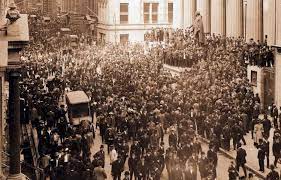Prior to 1907, The Knickerbocker Trust Company's headquarters stood sedately in Midtown Manhattan. It seemed nothing could shake the 23-year-old trust company. That all changed the morning of Tuesday, October 22, 1907, when many businesses, state banks, and local banks entered bankruptcy, leading to an economic downtown in the U.S.
How It Happened
The events preceding this day began after a failed attempt to corner the United Copper Company's traded stocks. The market bid was botched, causing runs in banks that had lent money to trusts that participated in the cornering scheme. The New York Stock Exchange's stock price dropped by 50% compared to 1906's. The panic that followed this crisis resulted in runs on trust companies and banks.
The effects sent shock waves to the affiliated trusts and banks. Many New York City banks retracted from the market, leading to a drawback in market liquidity and loss of confidence among depositors. Among them was The Knickerbocker Trust Company, which shut its doors until March 1908 after doling out approximately 8 million dollars to its depositors.
Another Trust Bites The Dust
A week later, New York City's third-largest Trust collapsed, spreading fear throughout the city's trusts. The panic went beyond New York when regional banks retracted their reserves from the city's banks. This renowned financial crisis lasted for three weeks and remains one that transformed the 1907 recession into a contraction.
The Aftermath
Unfortunately, the panic occurred during an economic recession in the United States. However, interventions by a financier, J.P. Morgan, prevented a severe crisis. He injected large sums of money to shore up the banking system and prevent the panic from deepening. The pain that occurred after this global financial crisis inspired monetary reforms, such as the creation of the Federal Reserve System in 1913.
Economists believe that the repercussion of the resulting contraction led to a severity close to that caused the Great Depression.

